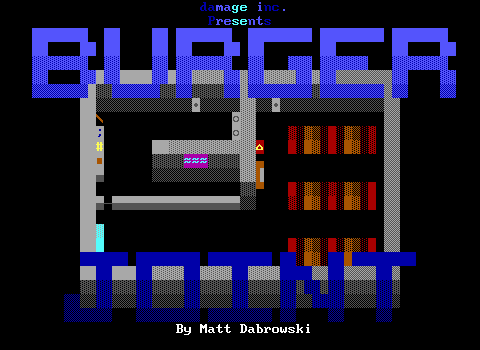Interactive Cinema Visual Novel
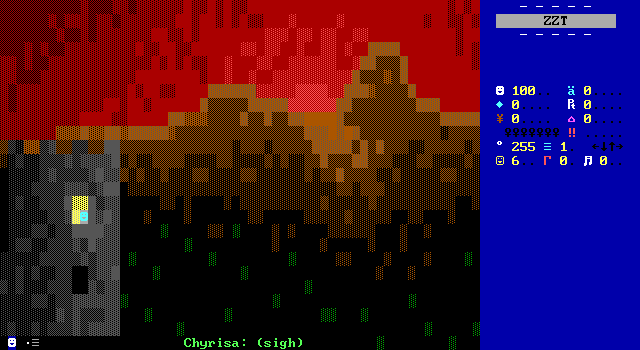
After spending some time away from the game, it occurred to me that while "Interactive Cinema" was perhaps the best label available at the time, there's a better term to communicate what to expect from Voyage of Four today. A more apt label for the game would be to describe it as a visual novel. The bulk of the player's time is spent reading dialog and watching characters move around the screen. WiL's level of interactivity early on is just letting players walk from point A to point B, but in later chapters the VN comparison feels far more fitting.
The game's second act focuses on princess Chyrisa of Rehana. Five years have passed since the events at Reed, and while the Outlanders have fought valiantly, it hasn't been enough. Much of the Outlands now under Tara's control. Making matters worse, the kingdom of Rehana has also begun to encroach into Outlander territory, turning an already devastating war into one now being fought against two enemies from both sides of the land.
Rehana differentiates itself from Tara in a few ways. Firstly, they're a little nicer about the whole war thing, at least as much as one can be. Their own war efforts opt to not raze entire cities in the name of victory, wanting something to control more than to wipe the slate clean. Unlike Tara, the kingdom seems to be more conflicted about the war effort. It's soon revealed that the king is being manipulated by his son Ardus, who himself is being lured to wickedness by a the other son Dillan.
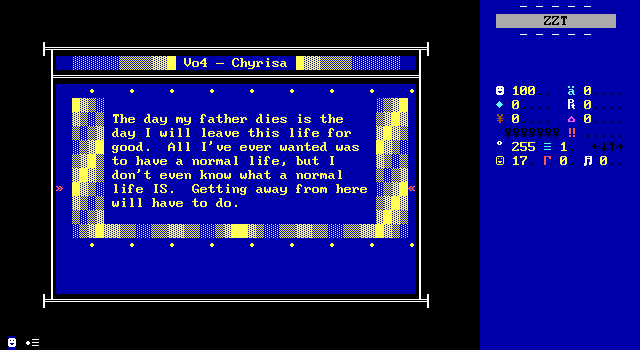
When players take charge of Chyrisa they learn that she doesn't want any war. What she wants is to escape her royal upbringing and lead a normal life free of the responsibilities of being a proper dignified princess. Upon discovering a plot between Ardus and Dillan to usurp the throne she flees the kingdom to the Outlands, fearing for her life. She gets what she wants, and immediately realizes that she is hardly prepared to lead a "normal" life by Outlander standards.
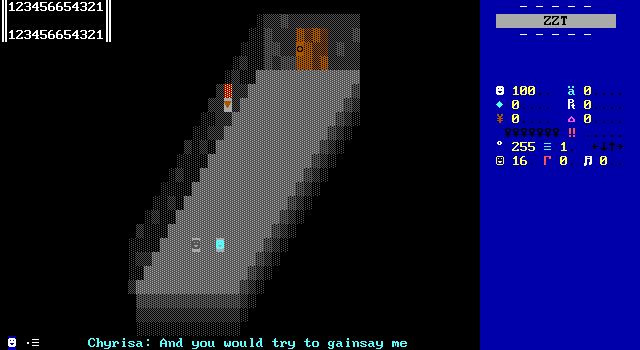
At first, the interactivity featured throughout this act isn't a welcome addition. Chyrisa's escape depends on getting away from a guard her brother ordered to tell her the king wished to see her. This is done with what is intended to be a simple mini-game, that ends up being an unusual flub of WiL's coding. An object appears in the corner and moves both of its own accord and in response to player input. Players have to stop the object on a six space in order to have Chyrisa shove the guard and make a run for it. Anything else gets the guard to make use of his sword to force her to her room. No problems so far. The concept is reasonable enough.
Alas, a mistake in the object that handles locking in the meter causes it to run at cycle three rather than the intended cycle one[2]. This leads to a random delay depending on game tick of 0-2 cycles during which time the meter continues to adjust. With the random delay, the ability to nudge the meter in either direction is unreliable causing the exact moment to stop the meter successfully to be dependent on the game's current tick. It boils down to luck when it's meant to be a test of your reflexes.
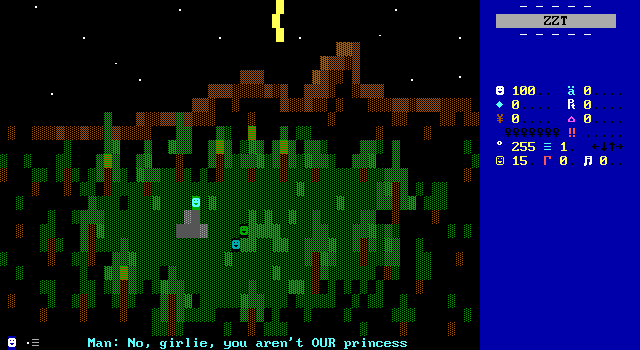
Her fish out of water story makes her the focus behind the majority of the interactive elements of the game. She joined James and Cyros after they come across her crying for help in the woods at night[3]. Even Chyrisa recognizes their names when she hears them, considering them to be legendary figures. The two are revealed to have not been apart for long. Both having deciding the best thing they can do would be to travel the Outlands, keeping ahead of the slow moving Tara armies, preparing and joining the villages for their inevitable battle for survival, and hoping to bring an end to the war altogether. Plus for Cyros being in these battles is his best chance of finally meeting the man in red.
And then tagging along with them is her royal highness Chyrisa?
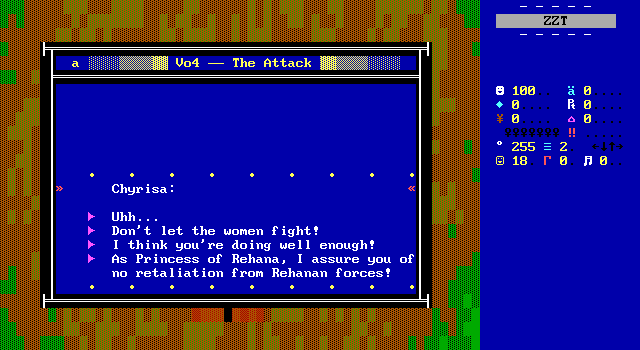
Chyrisa is woefully unsuited for the life she now finds herself in. She knows nothing of the people, having her share of prejudices to overcome. At one point the group tells a village elder to send the women of children into hiding so they can be spared. Said elder tells them that women are equals in this village and will fight alongside the men, opting to only send off the children. While James and Cyros are quick to respect their customs and move on to more important things, the idea nags at Chyrisa. When her insight is asked for by the elder, players get to choose a response, and a poorly thought out remark can quickly derail the strategizing.
Her offers to directly aid her newfound guardians are rightfully shot down, as she lacks any real training. In battles she does have a longbow, and thankfully her aim is no worse than anyone else's, but within the story she is described as being excited to hit a target anywhere at all. In many ZZT games, this would be the extent of her role. The girl who sucks at everything and needs to stop getting in the men's way.
WiL does not do this.
Chyrisa instead is to be treated realistically. She is trying. She is improving. She just has a way to go before she can truly move past her previously pampered lifestyle. Throughout the act players are given plenty of prompts for what Chyrisa should volunteer to do, or what to say, and being honest about her abilities and the way she can currently help is always the way to go.
So while it is possible to end up with her fighting in a battle whose outcome is handled through text and not the RPG engine, it's a risky move. One path actually has the game roll a random direction to determine if she manages to survive. Her time as a hero will come eventually. For now, she needs to live so she can grow as a person, a fighter, and a symbol to the Outlanders.
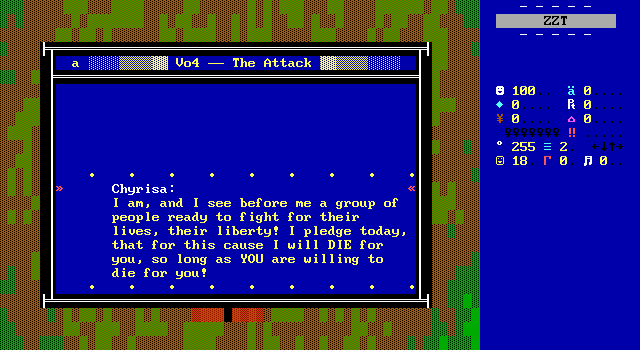
Players will find better results not trying to send her into the fray, or questioning "strange" (egalitarian) customs. What she can do, if she can't yet fight, is rally. Chyrisa's royal upbringing makes her an excellent speaker when she needs to be. She'll be making banners to boost morale, and giving impassioned speeches about how she is ready to fight, and ready to die for the freedom of these villages. Her status as princess to most folk is just a rumor which, depending on how well players manage to get her to contribute can become known.
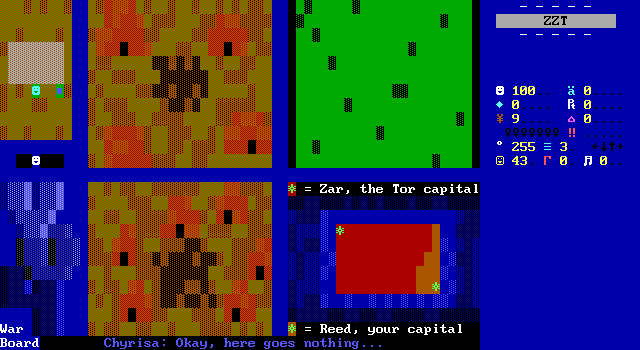
Most of the decision making is limited to just two boards, the latter of which is a really impressive one broken up into several smaller scenes that play out the events based on your choices. Way back when I played through November Eve, I was impressed at the linked board that effectively puts three cinematic scenes onto a single board. WiL goes beyond that with the "War Board", split into five sections depicting different events. One of which is dedicated to displaying who currently controls what land.
A disclaimer states that it's even possible to die here! How's that's for an interactive cinema?
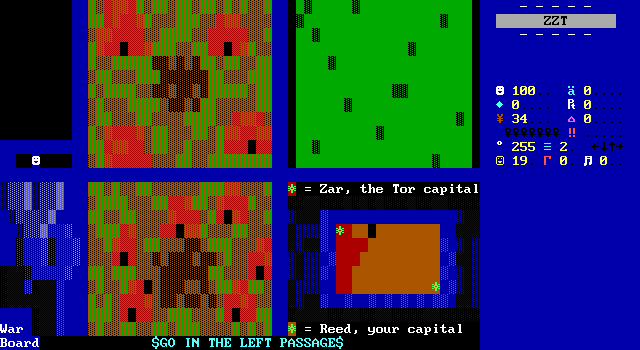
But by playing your cards right, Chyrisa can become a symbol of the Outlander's strength and perseverance. With her, James, and Cyros guiding the people slowly to victory, the borders of the kingdoms can be pushed back to nearly pre-war positions.
The Tara-ble Truth
How the story unfolds really depends on these moments. I was successful enough that I soon found myself pushing forward to attack Tara where the nature of the game suddenly changed dramatically.
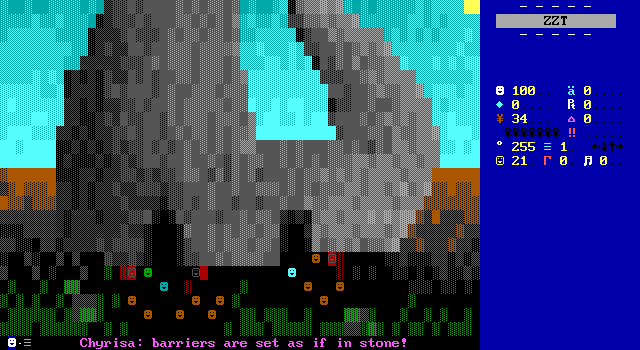
Stuck outside a Tara castle being defended by a magical barrier, finding a way inside becomes the next order of business to finally bring an end to this war. Inside is none other than the man in red, and Cyros so desperately wants that confrontation.
This is where the fourth member of the group finally makes an appearance. A seemingly possessed James begins speaking cryptically "...he is coming...". Panic begins to set in for a moment when a bird suddenly lands on Cyros's shoulder and the group realizes that whatever force has such a hold on James is coming from the bird resulting in what is to my knowledge the first time a bird has been slapped in a ZZT game. (No doubt foreshadowing WiL's later work.)
It's cool. Just a little mental freak-out from being spoken to telepathically by a bird. Said bird is of course Argyle the wizard, a character that shows up rather late into the game. Granted, the game is called Voyage of Four. I'd probably have been annoyed to have him show up suddenly when everybody else had time dedicated to developing their personalities. Fortunately, Argyle does not speak in anything other than birdsong, so he feels rather interesting immediately despite not being able to grow over the events of the game as the other characters have.
Argyle's communication is handled via James, and this is where the story takes an unexpected turn, that didn't originally sit well with me. Tara, while not completely innocent, isn't entirely to blame for the brutality of the war they started. Two beings of immense power had been summoned from another world. One's identity remains a mystery, with James explaining for Argyle that their name is not to be spoken out loud even in daylight. The other, is Ogilio, better known as the man in red.
So yeah. There's a world of darkness in another dimension. Surprise!
Argyle led the adventurers through the
long, smooth, cavernous passageways that
twist through the castle's innards like
intestines. The other adventurers
learned much about Argyle and his reasons
for being at the castle, and about the
Taros Umvir's drastic affect on the
balance of light and darkness. They
learned more of Ogilio, the mysterious
"Man in Red" whom they had chased to this
very castle, and his origins in the
Underworld, along with a Djinn, which was
a creature so frightening that Argyle
refused even to speak its name. Both
needed to be banished in order to restore
balance. Argyle would face Ogilio with
them and if necessary, the Djinn as well.
• • • • • • • • •
Even WiL starts to hurry things along at this point. It would be easy to just fill page after page for this article merely summarizing every conversation in the game. Here, the pacing picks up considerably and what previously might have been a learned slowly over several scenes is summarized in a single message.
What would likely have been the (believed to be) final dungeon in a more traditional RPG is leapt over with the finally full party going from outside the gates to the room of Ogilio, the man in red. The goal suddenly changes from ending the war with a touch of revenge to restoring the balance between light and darkness. The presence of Ogilio and the djinn in this world is having serious ramifications for that balance. In order to restore things, they must be banished back to the underworld from which they were summoned and the portal between the worlds sealed.
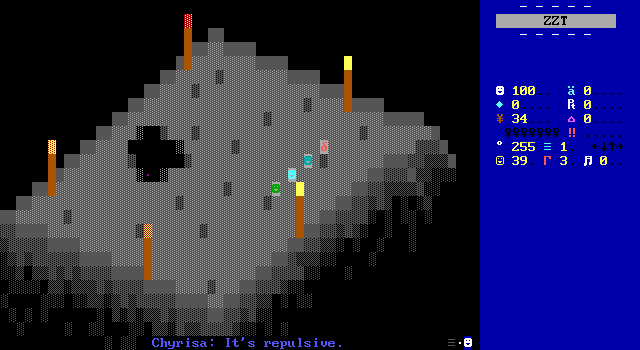
Okay, so the good news is that Ogilio must be a coward, and has already fled through a portal back to the underworld. Just gotta close it, and things will get a lot easier.
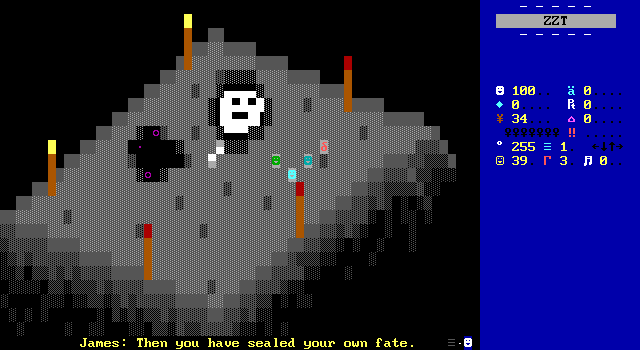
The bad news, is the portal is being kept open by the djinn who has just revealed himself to the voyagers. There's little conversation had, though it is worth noting that the djinn refers to group as "creatures of darkness" and is confident that good will triumph over evil and thus he will win.
This leads to what was my final RPG battle of the game, but there's still plenty more story to go. Once the djinn is defeated, there's no one left to keep the portal stable. It begins to a bit haywire, pulling everything towards it, forcing the group into the underworld.
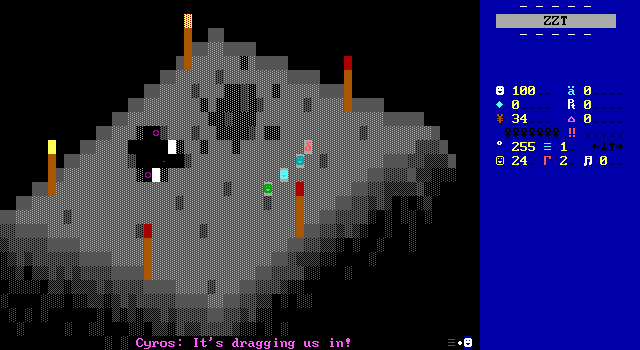
And that is when the first file ends.
Yeah, this is a longer one for sure. The game is split up into two files with the first not too far off from the old rule of thumb to keep your worlds under 300 kilobytes. The second file contains half the number of boards, but still weighs in at nearly 200 additional kilobytes, making for a very sizable world.
Reaching the second file does mean players are on the right path, but there are still mistakes that can be made. The second file has its share of alternate routes so things aren't wrapping up quite yet. Brace yourself for file two, because as is often the case when people travel to other dimensions, things are going to get a little weird.
Color Me Impressed
There's quite a lot to take in here. In the ways in which Voyage of Four is unique to other story-heavy ZZT worlds, it does a fantastic job. The RPG engine is of course fair game to compare to dozens more, and fares well above the average, offering large numbers of combatants, and creative mechanics such as the unusual method used for healing. Many of the fights felt as though they came down to the last blow, so it's no surprise that a few of them took multiple tries. It still feels like there isn't too much in terms of strategy as much of the decision making comes from when to use items that don't show up until the later battles.
Pit Voyage of Four against the console RPGs of the 90s that often served as inspiration for ZZT, and the professional studios unsurprisingly come out out on top. However, by ZZT standards, it's certainly enjoyable far more than it's not.
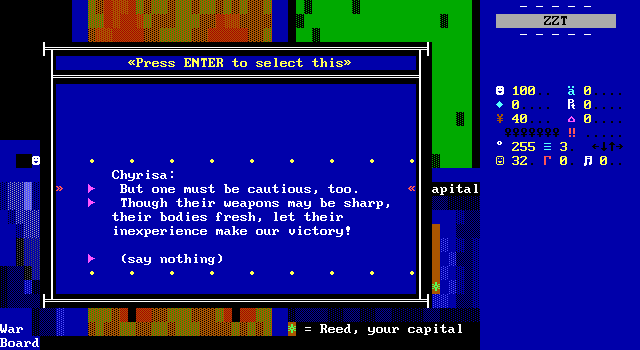
The RPGs are an obvious standout, but the decisions to be made as Chyrisa and the little war room simulation screen shouldn't be overlooked either. I only played through the game once, opting to check out some of the alternate paths via the Museum file viewer. There I was really surprised at how much the paths through the game could diverge. It's possible to be captured and taken to the castle rather than to assault it head on. You can end up having the game end in (what at least appears to be) a positive ending and then get an explanation that the game is called Voyage of Four because there's a fourth character in the other endings, meaning there's a way to not have Argyle show up at all. The story is compelling as-is even now, with most even well-received worlds feeling as if they don't do anything that hasn't been done before. WiL's story is supported by its assortment of characters that evolve over the course of the game rather than being set in stone the moment they appear. It's easy to find yourself looking forward to each passage the player traverses to see where the story will lead next.
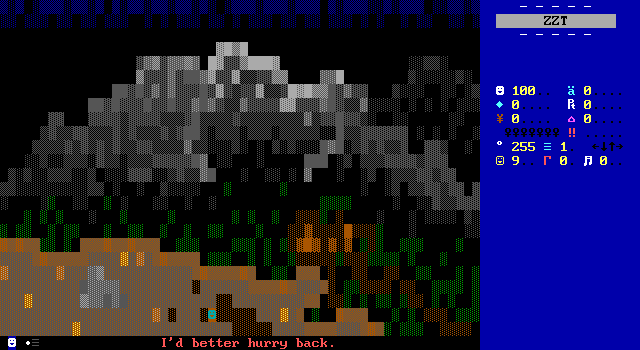
But really what sets this apart from serious ZZT stories such as Freedom, Rhygar, or Chrono Wars is just how much care has been put into the game's presentation. Not just in the static visuals, but also how many little extra touches have been added to keep scenes from just alternating between a smiley face talking and a smiley face moving.
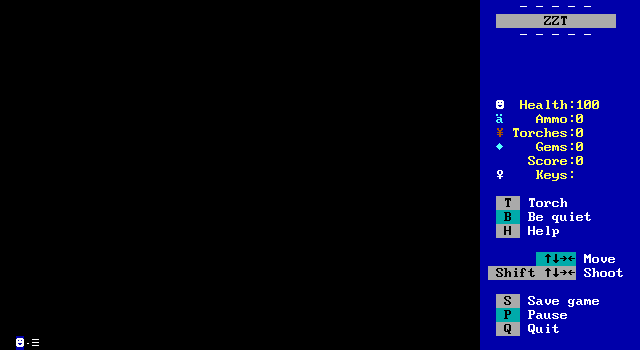
I was stunned by this scrolling text sequence that appeared early on. I don't think I've ever come across a game before that had so much text appearing, moving, and changing colors. It should come as no surprise to hear that this board just barely fits within ZZT's board size limitations. I feel as though anyone else at the time would have been happy to just stick with flashing text in the bottom row to present this information. Instead, so early on, WiL makes it clear that this is going to be a grand adventure, and will be treated as such.
Keep in mind as well that this game appears to have been made in ZZT v3.2. Though the external ZZT editor KevEdit would have been an option by this point, not everyone switched over the moment they had an alternative to ZZT's own editor. Flipping through boards and looking at the color of empties reveals several boards to have a border of yellow empties, indicating these boards began life as yellow bordered rooms as created by ZZT's own editor.
To create something like this without the use of an enhanced editor was undoubtedly a painstaking and delicate process. ZZT's editor has no copy and paste functionality. Every #char value had to be hand typed as a number, with no method to convert "A" to "65" automatically. This is something I shudder at the thought of coding up today, but WiL went for it, quickly demonstrating to players that no corners would be cut here.
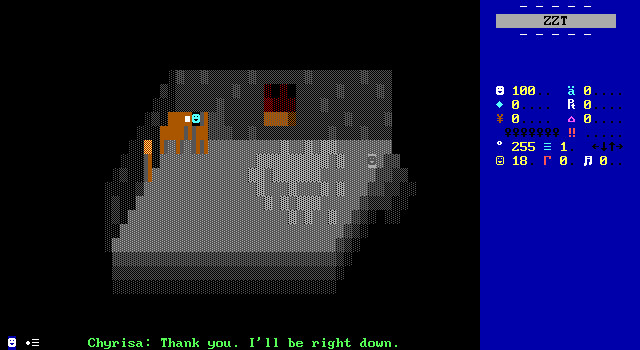
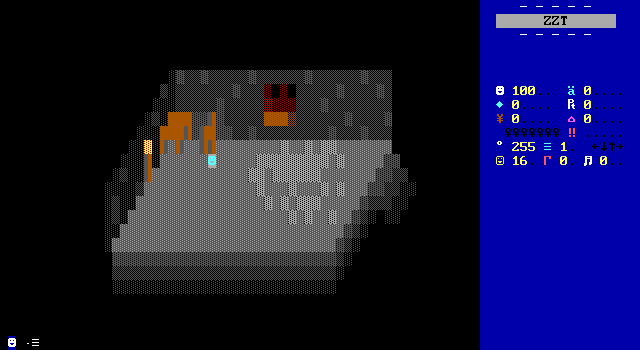
The scenes that make up the world go the extra mile as well. Here princess Chyrisa is writing in her diary when a royal guard tells her the king has summoned her. Again, the standard for ZZT is quick-and-dirty. You want a character to sit at a desk? Place them between a parenthesis character and a rectangle of brown solids.
Not WiL though. WiL goes for a much more complex isometric perspective and arranges his furniture along a diagonal. The items in the room are large and clearly defined without having to resort to shorthand. Again, in the past I've been impressed by folks like Nadir having characters slide chairs around to sit and get up. WiL does the same with larger arrangements of objects, carefully working fake walls along the northern wall in such a way that it feels like the natural lighting in the room and not a conspicuous spot for objects to shuffle around in.
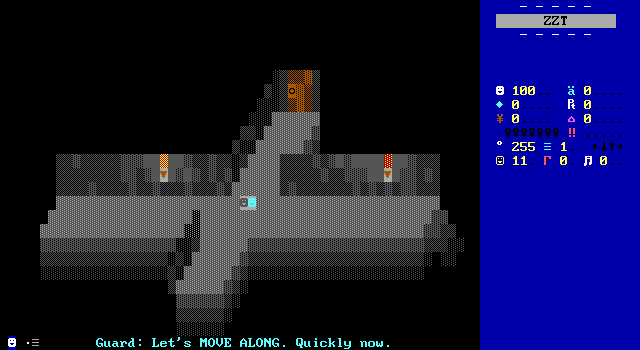
The smiley faces themselves that represent each character are no strangers to stage direction either. When Chyrisa catches Dillan and Ardus plotting something in the castle halls the guard escorting her has to act like he didn't see anything and keep her moving. She finds herself then being pushed more than escorted as the guard repositions himself behind her to actually shove her forward instead of telling her to move and having everyone move forward from the same positions. Small adjustments and reactions to those in a scene keep these cinemas from feeling still and convey what's happening rather than describing it.
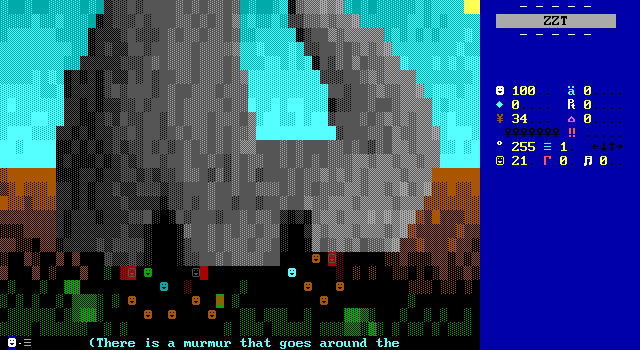
Another example that caught my attention was during the scene outside the Taran castle when James begins to act strangely. At one point a murmur goes through the soldiers the group is traveling with before the lieutenant asks if James is alright. "Murmur" isn't merely a word in the script, with the soldiers visibly shuffling around in discomfort at what they're hearing.
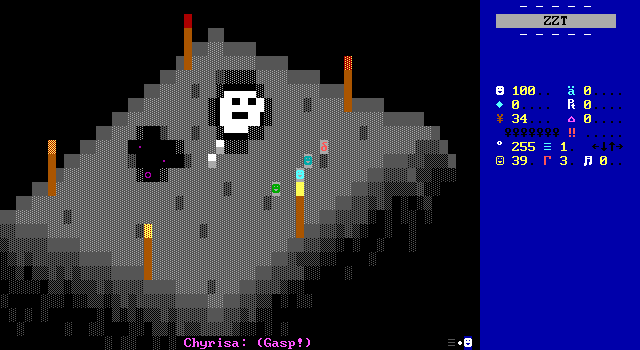
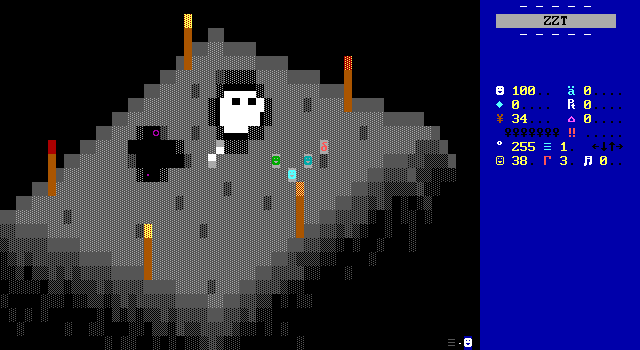
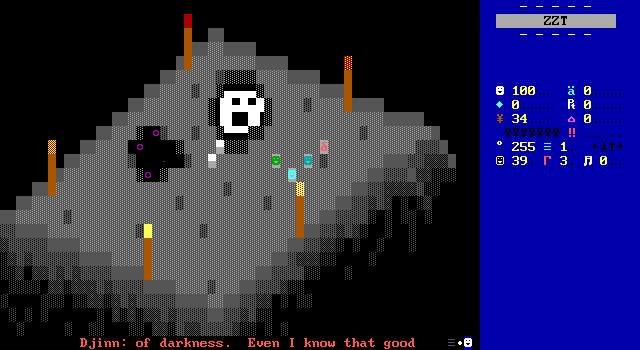
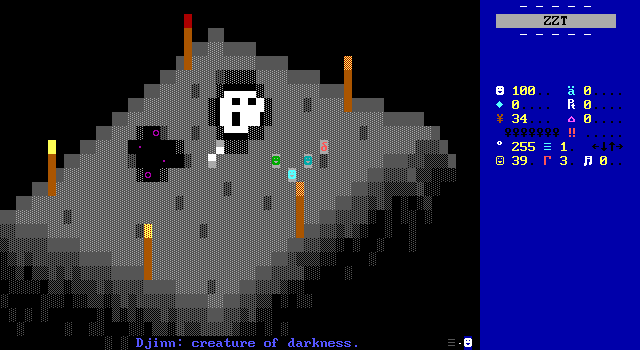
Then, of course, there's the almighty djinn, who looks more adorable than powerful. When he speaks though, he has a number of frames of animation for his mouth that put the infamous 3D Talk Engine to shame.
Roads Not Taken
Voyage of Four also stands apart from other cinema-focused ZZT worlds due to the way its story diverges. While other games like Freedom expected players to sit down and enjoy the ride, WiL has been making sure that players are more than just an audience. This isn't the sort of game I was expecting to have so many alternate paths. There are quite a number of alternate battles and scenes, some of which meet up with the main path that I followed while others end elsewhere.
It's possible to fight with the man in red in a very difficult battle. One which losing doesn't result in the game ending! A victory results in the unusual "Voyage of Three" ending where Argyle never shows up, instead simply closing with Cyros taking the man in red's cloak and belt as a symbol that his family has been avenged.
These alternate paths also help fill in details that aren't quite explained. I found myself curious as to why princess Rehana was admired instantly when her royal status was revealed to the people who were currently also being invaded by her family's lineage. These endings reveal what happened after Chyrisa left and combined with the initial reluctance of the king to invade, make it a lot more understandable why she isn't seen as a traitor.
These branching paths still continue into the second file, but we'll get to that next time.
Not Yet Final Thoughts
What's been covered so far is really Voyage of Four at its best. A game that finally feels like it was able to fulfill the promise of hooking players with a story, without needing to hastily reassure everyone that there's gameplay to be found here. That gameplay is there as well, which goes a long way towards more general appeal as a game to revisit twenty-some years later. WiL really seems to be able to do no wrong with this one.
I've hinted that the second file, what with it's sudden discarding of the war between Tara and the Outlanders loses the plot a bit, and yeah, it does. But this isn't something where things totally collapse. WiL will continue to create some fun and unusual environments, introduce a few new characters, and bust out some philosophy on the inevitability of change. Things will just get introduced at a much quicker pace where the four voyagers are really thrust into things and just kind of have to run with what they're told for the fate of both worlds. I really enjoyed the slower buildup of the game's first file and its focus on the people more than the setting. File two is no disappointment, and it's nice to actually see what Ogilio's deal actually is.
As for file one, the branching paths give players a good reason to revisit the game and see what other ways things might unfold. Much amusement at one of the endings here making it desperately clear that there are alternative ways for things to end, going so far as to have a looping message after the game over that displays "SEVERAL ENDINGS". The main path that I just so happened to run through myself definitely seems like the "correct" one, though I appreciate the alternate endings still feeling complete and satisfying. That little warning probably was a smart idea though, as you really would be missing out to not get the ending this playthrough headed towards.
In fact, that's one of the strengths of Voyage of Four. WiL offers up all these routes, but the biggest and most impactful gets an edge over the rest with some subtle ways to steer the player without forcing them to go there. The very first time players get to choose how to handle a situation as Chyrisa, there are two roads, and one will end the game without a proper ending. It's all a trick to get players into thinking that making poor decisions to see what happens will just lead to a reload. Afterwards, you're allowed to choose poorly as much as like, with the game handling the consequences of that. The assault on the castle can be presented as the logical conclusion of the Outlanders' triumph over their adversaries or it can be presented as a desperate last hope. Argyle can get you into the castle, or he can break you out of the castle's prison. Many roads converge on the battle with the djinn over the portal, and that's where you need to be to keep the story going.
It's an ambitious title that really manages to deliver, and one that's well written enough for that to still count today. It was a Game of the Month winner for it's original release whose review brings up some of the competition it had, namely King's Quest ZZT 2 and Mr. Shapiro Cares Not For Snakes. The former would have been excluded from the award as it was worked on by Hydra who was doing GotM reviews, and the latter is a short title about fighting ZZT centipedes without having any ammo.
I'd say the right choice was made there, but I was curious how ready the ZZT community was for a game like this. The RPG sequences would hopefully fend off any criticisms about a boring story world with nothing to do, but would that be enough? It looks like that was the case, yet even Hydra's review laments that it's only an interactive movie. If only it was a "normal ZZT game (in which the player actually can do things)".
Ouch. That's rough.
Hydra goes on to say that if it was such a game that we could be looking at the next Rhygar showing that the idea of what a great ZZT game was still required it to adhere to gameplay first and foremost. With only a single other review to its name, it seems the game didn't have an enduring legacy. The poor thing never got a later "Featured Game" award while WiL's earlier Run-On and Banana Quest did. The Featured Games era of z2 is a pretty spotty record admittedly, with lots of folks willing to nominate games and very few willing to write a review. In turn, this one feels almost overlooked.
So if you haven't seen this one, now's a great time to try it out for yourself. WiL's name implies quality, even with older releases like this one, but I was really caught off guard by just how well put together this game was. It avoids the usual clichés of medieval fantasy ZZT games, creates memorable characters, and puts you in charge of achieving their goals. Give it a shot.
Oh, and by the way, there's a tremendous amount of music that scores many of the game's scenes. I've yet to even touch on that aspect of the game.
To be continued...

